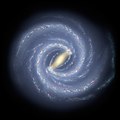| Willman 1 | |
|---|---|
 | |
| Observation data (J2000 epoch) | |
| Constellation | Ursa Major |
| Right ascension | 10h 49m 22.3s [1] |
| Declination | +51° 03′ 03.6″ [1] |
| Distance | 124 ± 23 kly (38 ± 7 kpc) [2] |
| Apparent magnitude (V) | 15.2 ± 0.4 [a] |
| Characteristics | |
| Type | extreme dSph or unusual star cluster [1] |
| Apparent size (V) | 4.6+0.4 −0.8′ [2] |
| Other designations | |
| SDSS J1049+5103 [1] | |
Willman 1 is an ultra low-luminosity dwarf galaxy or a star cluster. [3] Willman 1 was discovered in 2004 and is located near Ursa Major in the night sky. [4] [5] It is named after Beth Willman of Haverford College, the lead author of a study based on the Sloan Digital Sky Survey data. [6] The object is a satellite of the Milky Way, at ~120,000 light-years away. [7] Willman 1 has an elliptical shape with the half-light radius of about 25 pc. [2] Its heliocentric velocity is approximately −13 km/s. [3]
As of 2007, it was declared the least massive galaxy known, opening up a new category of ultra-low-mass galaxies, lower than the then-theoretical minimum of 10 million solar masses thought to be needed to form a galaxy. [8]
As of 2016, it is the third dimmest likely galaxy known, after Segue 1 and Virgo I, and is over ten million times less luminous than the Milky Way. It has an absolute magnitude of −2.7 ± 0.7. [2] Observations indicate its mass is about 0.4 million solar masses, which means that Willman's 1 mass to light ratio is around 800. [3] A high mass to light ratio implies that Willman 1 is dominated by dark matter. [9] [10] It is difficult, however, to estimate the mass of such faint objects because any mass estimate is based on an implicit assumption that an object is gravitationally bound, which may not be true if the object is in a process of disruption. [3]
The stellar population of Willman 1 consists mainly of old stars formed more than 10 billion years ago. [11] The metallicity of these stars is also very low at [Fe/H] ≈ −2.1, which means that they contain 110 times less heavy elements than the Sun. [3]
